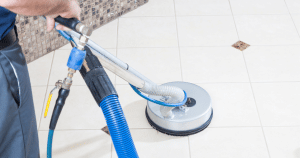
Tiles and grout lines are among the most difficult and unpleasant locations to clean in your house or office. When those grout lines turn black or yellowish, you feel there are many microbes.
Fortunately, we’ve written this post to provide you with some helpful tips from our professional tile cleaning service. We hope you’ll be able to conveniently remove those annoying dark lines, molds, and mildews from your ceramic or porcelain tiles.
To learn more, keep reading. Enjoy!
Basics About GroutÂ
Grout is used to keeping your tiles together and on the floor. It’s made up of various ingredients, including sand particles, white colorants, water, and cement. Because it is porous, it is susceptible to stains and bacterial growth if left unattended for days.
Furthermore, what’s the difference between a sanded and an unhandled grout?
- For grout that is broader than 1/8″, sanded grout is used.
- Unhandled grout is 1/8″ broad or less.
However, the third type of grout is epoxy grout, utilized in bathrooms and kitchens. This variety is more resistant to stains, dampness, and dirt particles.
Do’s For Tile and Grout CleaningÂ
- To avoid dirt buildup, vacuum or mop your tiles and grout regularly.
- Keep the space around your shower and tub well-ventilated to avoid excess moisture, encouraging mold and mildew growth.
- For daily sanitation, exclusively use pH-neutral tile and grout cleaning products.
- Wash or replace your mops when cleaning your floor tiles and grout lines.
Dont’s For Tile and Grout CleaningÂ

- When it comes to cleaning your kitchen and bathroom tile and grout, soap-based treatments are rarely suggested. As a result, it leaves a thin film of soapy residue on your grout lines, dulling your tiles.
- Avoid using acidic or basic cleaning agents when cleaning your tiles and grouts because they can cause etching and dullness.
- When cleaning your ceramic tiles and grout, never use steel wool or abrasive scrubbers.
Cleaning Your Ceramic Tiles and Grouts
With our years of experience in residential and commercial tile and grout cleaning, we developed an efficient and effective method. Here are the basic techniques for restoring the whiteness and neatness of your porous grouts and tiles.
- Before scrubbing or washing your tiled surface, make sure it’s clean. With that, you can do the following three things:
- Dry Mopping, Sweeping, or Vacuuming: These methods remove bigger debris and grime from your floor and wall tiles.
- Hot Water and Sponge: Another excellent approach for collecting those piles of filth and scums on your tiles and grouts is to use hot water and a sponge. The obstinate black and yellowish stains melt in hot water, allowing you to remove part of the first layers.
- Stagnant Water: Remove any pool or stagnant water accumulated on your floor tiles. You are thereby preventing the growth of molds and mildews.
- You can use either a DIY cleaning product or a commercial tile and grout solution for the major scrubbing. You can’t use very acidic or basic cleaning chemicals on your ceramic tiles, so check the label carefully.
- You can scrub and agitate your tiles and grouts manually or with a counter-rotary brush.
- Gloves are required for manual scrubbing, and an old toothbrush or other soft-bristled nylon brush can be used.
- A sponge, mop, or wet vacuum can remove extra foam and dirt.
- Rinse the area well with water.
- If necessary, you can also re-seal your grouts.
When you wash and disinfect your floor and wall tiles yourself, you save a lot of money; but contacting a local grout cleaning service is your second-best alternative if you don’t have the time.
Is Bleach Safe to Use on White or Neutral-Colored Tiles?
Bleach can be used to some extent, but it must be diluted to avoid discoloration and etching. Allow 10 to 15 minutes to dry after spraying a suitable amount on the soiled or unclean area. After that, could you give it a good rinse with water?
Is it possible to make your tile and grout cleaning products?
You can clean and restore the hygiene and whiteness of your ceramic tiles with a few common household goods. Fortunately, you can use baking soda and hydrogen peroxide as a stand-alone or mixed cleaning reagent.
These two common home substances work wonders on dark and yellowish stains on your tiles and grout. Furthermore, unlike bleach and muriatic acid, it will not destroy your ceramic tiles.
Similarly, use non-abrasive scrubbers such as an old toothbrush, cloth, sponge, or soft-bristled nylon brush while cleaning your ceramic tiles.
How Do You Get Rid Of Faded Grout Colors?

Your excellent ceramic tile and grout cleaning technique may also be unable to restore the original color of your grouts. There’s no need to be concerned because grout colorants can solve this problem.
Grout colorants that match the color of your grout lines can be purchased at any hardware or home improvement store near you. It operates in the same way as paint, so it’s easy to use.
However, before adding any grout colorant to restore the appearance of your tiles and grouts, you must first clean them.
Hire a Professional Cleaning Company
If DIY cleaning isn’t an option, consider hiring a local cleaning business like Atlanta Top Force Service. We provide a comprehensive range of floor cleaning services for homeowners and businesses.
Because it ensures thorough washing and stain removal, our tile and grout steam cleaning process has acquired the most client recognition. In addition, we offer affordable tile and grout cleaning services that meet any budget.


